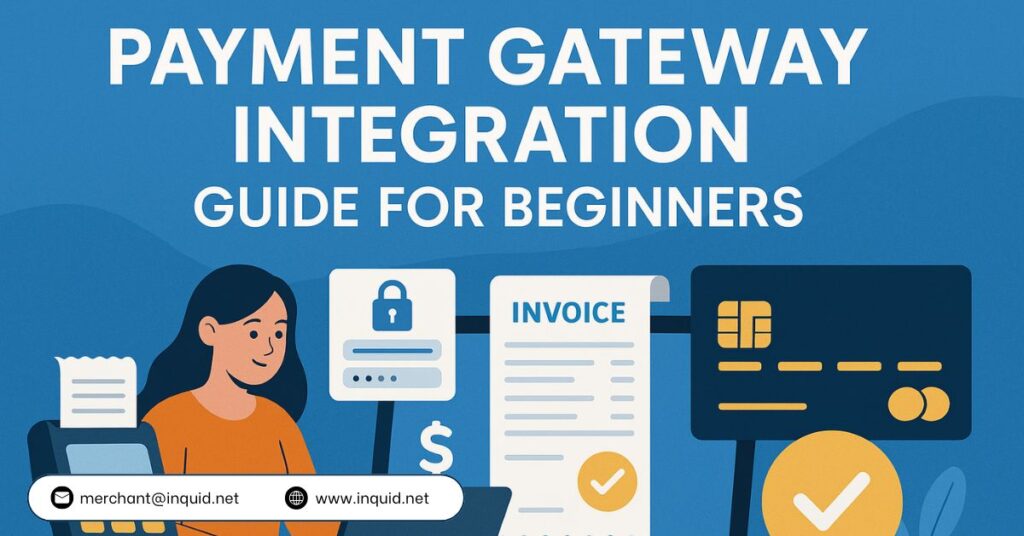
Getting a payment gateway working on your site might feel daunting at first, but breaking it down into clear steps makes the task manageable. This Payment Gateway Integration Guide for Beginners covers what you need to know to start accepting online payments, with practical tips and links to helpful resources along the way.
What Is Payment Gateway Integration
A payment gateway handles the exchange of payment data between your website and the bank that issues your customer’s card. When a shopper enters their card details, the gateway encrypts that information and sends it on for approval. Once the bank replies with an approval or decline, the gateway passes that status back to your site so you can complete the order.
If you want to see how a modern provider handles these steps you can explore inquid’s payment gateway offerings.
Why You Should Add a Payment Gateway
Adding a gateway opens up multiple ways for people to pay you online while keeping card data secure. Key benefits include:
- Accepting major cards and popular digital wallets
- Meeting industry rules for handling card details
- Keeping shoppers on your site during checkout to reduce drop‑offs
For a closer look at the company behind these options visit inquid.
Picking the Best Provider
Choosing the right partner sets the tone for your integration process and ongoing support. Look at:
- Pricing model for setup, monthly fees and transaction costs
- Support for local payment methods if you sell internationally
- Quality of developer documentation and sample code
- Extras such as fraud monitoring, reporting dashboards and test tools
Testing several gateways in parallel can reveal which one best fits your needs. Reach out to their teams if anything seems unclear.
How Integration Works
You typically choose between handling payments on your site via API or sending shoppers to a hosted page.
API Integration
With API integration you build your own payment form and send card data directly to the gateway. You maintain full control over the checkout layout but you must meet data security standards on your server. Key steps are:
- Get sandbox keys from your provider
- Install the gateway’s SDK or library for your programming language
- Build a form that collects card details or generates a token
- Send the data to a payment endpoint and wait for the result
- Record the response in your order system and show confirmation
Hosted Checkout
A hosted checkout redirects the customer off‑site to a secure page managed by the gateway. You add a simple button or link, and the rest is handled externally. This reduces your compliance burden but can feel less integrated. Typical flow:
- Redirect shopper to the gateway’s URL with an order reference
- Shopper completes payment on the gateway’s page
- Gateway sends the shopper back to your confirmation page
- A webhook or callback notifies your site of the result
Setting Up a Test Environment
Before going live you’ll want to run through both successful and failed transactions. Your provider’s sandbox lets you:
- Verify that orders are logged correctly on success
- Check that errors such as declined cards show useful messages
- Inspect webhook payloads to confirm your endpoint parses them right
You can use a tool like ngrok to expose your local server for real‑time webhook testing.
Dealing with Common Errors
Even after integration some issues can show up. Here are fixes for a few:
- Card declines
Show the exact error text returned by the gateway so shoppers know what went wrong. - Webhook failures
Confirm your endpoint URL is correct, that your server accepts POST requests, and that SSL is valid. - Slow responses
If your server takes too long to acknowledge a request the gateway may time out. Make sure your code handles calls quickly and retries if needed.
Going Live with Real Payments
When you’re ready to switch from test mode to real transactions:
- Replace sandbox keys with live API credentials in your settings
- Verify your site runs on HTTPS so card data stays encrypted
- Invite trusted colleagues or customers to place small test orders
- Keep an eye on your gateway dashboard for any unexpected errors
What Comes Next
Once basic payments are working you might add:
- Recurring billing for subscriptions
- Support for multiple currencies
- In‑app payments via mobile SDKs
If you need advice or run into questions at any point please contact us and our team will guide you through the next steps. Enjoy building your checkout flow!
